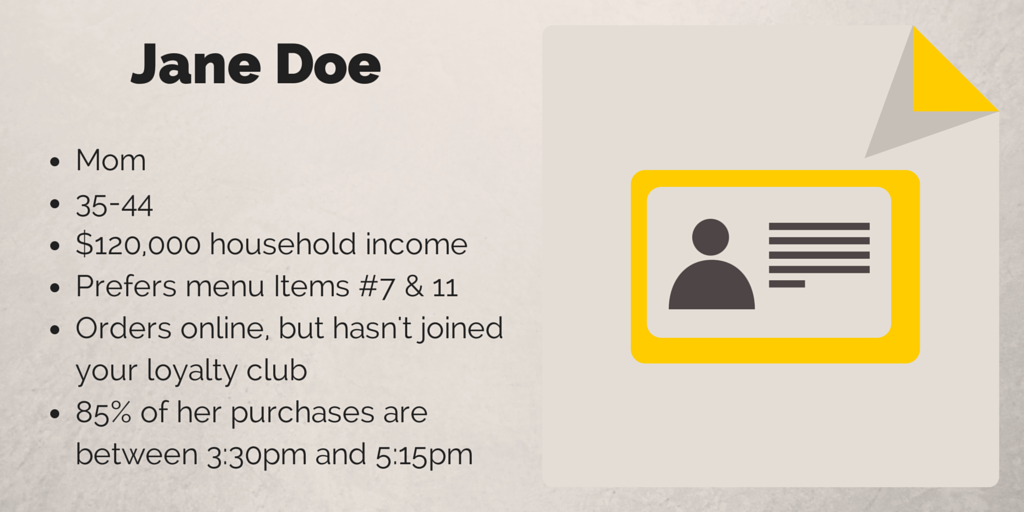
For years and years, restaurants have been doing an entry-level form of market segmentation.
Demographics have primarily driven restaurants’ decisions in creating these segments. Age. Gender. Household income. Education level. Psychographics have influenced some decisions as well. Makes sense.
But you could make a very, very strong argument that we, as an industry, have done a poor job of even leveraging those known details in our marketing. I subscribe to hundreds upon hundreds of restaurant email newsletters, for example. Know how many of them prove they know that I am: male, 35-44 years old, based in Southern California (restaurants don’t get bonus points for merely pointing out the closest location), a Kansas City-area sports fan, and/or a Mexican-food lover in particular?
None do that.
So, are we even ready for more advanced segmentation?
Honestly, probably not yet for most restaurants, but it’s a great opportunity for forward-thinking restaurateurs and marketers to get on this.
MarketingCharts.com reports that marketers are still relying heavily on simple, personal data from consumers to drive their “personalized” marketing. Less than half are using user preferences, let alone the data I think restaurants really need to start leveraging.
Let me step back for a minute and breakdown what I mean when I say “advanced segmentation.”
No what hasn’t driven much restaurant marketing and operations decisions? Highly specific customer buying behaviors — as in, customers’ individual purchase history.
Sure, restaurant operators have made decisions for years based on aggregate data, or the feel they have for groups of customers they see in their restaurants, and those groups of customers’ visible behaviors. Their afternoon regulars. Their happy hour crowd. Their morning breakfast crew.
The key words in that last paragraph are “groups” and “visible”. Marketers see spikes in your sales when looking at specific dayparts in your POS data, and you make staffing changes accordingly. Operators remember you’ve got those Toastmasters coming in on Thursday mornings and you remember what they buy, generally speaking.
That’s why I’m really excited about the work being done at several companies to help restaurants segment their customers based on advanced factors. We live in the age of personalization, and it’s not just for the biggest brands.
Quick note here, too, as we get started. I want you to bookmark these articles for more on this subject after you’re done reading here:
- What Types of Data Are Marketers Using For Personalization – And What’s Their Impact on ROI? from MarketingCharts
- Get to know your customers. Like really get to know them from LevelUp
- Bring your own persona: Rethinking segmentation for the new digital consumer from Wharton
- The new era of personalization has arrived from Infinite Analytics
- Effective targeting can cut down customer acquisition costs from Plumb5
Market segmentation means much more than you think it does
Now, you’re forgiven if you haven’t really segmented your customers to this degree. Truly powerful market segmentation for restaurants has been limited because there hasn’t been enough information available to glean insights from it…let alone a way to centralize it and actually, you know, USE it.
That’s the other factor: it’s been limited because even if you COULD create 10-15 smart market segments, you’ve lacked the ability to efficiently craft and send compelling messages with relevant offers. There’s been no point to creating all of those segments because you don’t have the time or resources to send personalized messages to each group.
But the day of personalization in a scalable way is here.
Restaurants are increasingly able to take their simplistic market segments based on demographics and psychographics and turn them into behavioral segments. And by “behavioral,” we don’t merely mean whether they clicked on an email or not.
Welcome to behavior-based market segmentation
Check out the image at the beginning of this post. Does it mystify and/or excite you that you could know those types of insights about your customers?
Forget sending the same marketing message to all of your customers. How would it change your marketing approach, if you knew you could more precisely group your customers into segments based on what they do — when they eat your restaurant, how they most often order, what they eat (and what they don’t), which offers appeal to them (and which don’t)?
What it takes to get to this kind of market segmentation
Deep data dives into your loyalty program, assuming you have one, or into your online ordering, assuming you offer this at your website or from within an app, can get you started in building behavior-based segments. Getting an outsourced provider to append data to your email list can give you the demographic data you crave, too.
It starts with aggregating the data you’re already compiling. Your loyalty partner probably isn’t your online ordering partner, which isn’t your email marketing partner. You’ve got to aggregate the data from all of the vendors. Get it into one database, one combined resource. There are an increasing number of companies who promise to help with this — be sure to ask which vendors’ data they can collect and how they’ll keep your data secure. Zipscene. Fishbowl. Splick.it. Those are three who will work with the big brands.
It continues with decoding that data — what does it tell you? What segments can you build? Are there people who appear on your email list, as users of your mobile app, and as regular online orderers? If you’ve got the manpower, you can partner with a company like Tower Data, or DataSift, or V12, and you’ll be ahead of the curve in truly knowing who your best customers are.
Finally, it’ll end with leveraging that data. That’s where you make the magic happen and re-segment your email lists, your SMS lists, re-energize your paid social media advertising, and other marketing efforts. You send offers and promotions to people based on who they are, how they’ve interacted with you, what they’ve bought you before, and what they haven’t.
And seriously, some big restaurant brands, as well as some small ones, are just a step or two away from making this a reality right now. Will you join them?
What do you think?
If you’ve received offers as a consumer that are, or seem, highly personalized, let us know. If you’re already segmenting your customers in precise, behavior-based ways, share your story with us via the comments below or our contact form!






